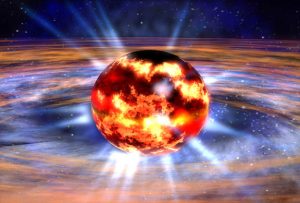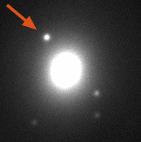Roughly a month ago, neutron stars made it to the headlines. For the first time, we were able to see two neutron stars colliding with each other. Why is that interesting?
Neutron stars are collapsed cores of large stars*. They are very, very small and dense objects, typically compacted to a diameter of 10 km. A teaspoonful of neutron star matter would weigh the same as 50 000 large locomotives. Sometimes, neutron stars come close to each other and eventually collide violently emitting a vast burst of not only electromagnetic radiation but also gravitational waves. Gravitational waves are very curious waves that do not need an extra medium to propagate, they are ripples in the curvature of spacetime itself.

By measuring to a high precision how space is distorted here on Earth, we can detect gravitational waves. As a result, we were able to “see” two neutron stars colliding 130 million light years away through their gravitational wave signature. This was made possible by cutting-edge technology developed by this year’s Nobel physics prize laureates and their teams, LIGO in the USA and Virgo in Italy. Previously, gravitational waves had been seen from the coalescence of massive black holes but this time there was also an electromagnetic counterpart visible to our optical telescopes. This confirmed the colliding objects were indeed neutron stars and not black holes, which do not emit light at all.

LIGO and Virgo observed on 17 August 2017 a gravitational wave event with the signature of a binary neutron star merger. This led to the search for the event’s optical counterpart, that was eventually found in a bright new source associated with the galaxy NGC 4993. The bright optical emission declined over the following two weeks. Image credit: The Dark Energy Camera GW-EM Collaboration and the DES Collaboration.
Despite this being a remarkable achievement, one cannot say that cosmologists would have been surprised, as both neutron stars and gravitational waves have been known to exist for a long time. However, the true value of the recent observations is three-fold.
The first thing is that by observing gravitational waves scientists actually opened up a whole new observational window. So far, we have only been able to study objects in the sky in one way: “looking” at them, that is, utilising the spectrum of electromagnetic radiation from gamma rays to radio wavelengths when observing different targets in the celestial sphere. Studying gravitational waves provides a whole new and complementary way to make precision measurements of distant objects. It is like getting a new sense unlike any other we have.
The second aspect is related to things that scientists think are not explained by Einstein’s theory of General Relativity to a satisfactory level. Because of that, theoretical physicists have developed new theories of gravity, and observations of gravitational waves help in testing them. In particular, observations help to evaluate whether any of these “modified theories of gravity” can provide an explanation for the mystery of dark energy, an unknown energy density component making the universe expand at an accelerating pace at the present epoch. Furthermore, observations of gravitational waves originating from neutron star collisions can be used to study the structure of neutron stars, which is an interesting topic from the particle physics point of view.
The third thing is the most important. Discovering a collision of two ever so distant and alien objects by its gravitational wave signature tells us that the universe is within our reach, that we can understand it in detail. Nothing shows us our place better than a message from the heavens carried by gravitational waves: in the deep darkness of space neutron stars of gargantuan masses violently collide into each other and literally bend the space around them, and yet, here we are, safe and sound. Everything could be different but we inhabit a safe island in the middle of a vast ocean we call the universe. It is one of the most joyous things I know.
Written by Tommi Tenkanen
The author is a postdoctoral researcher at the Queen Mary University of London
*Not all stars become neutron stars at the end of their life, for example our own Sun will spend its late days as a so-called “red giant”.